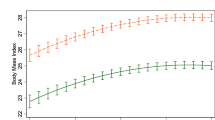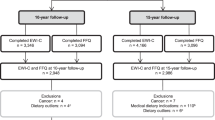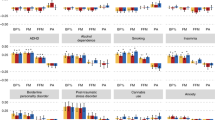Abstract
Objective:
To explore the association of eating styles with overweight and obesity in young adults, controlling for identical genetic background in monozygotic twins.
Design:
Prospective twin cohort study.
Setting:
Finland, 1991–2002.
Subjects:
Two-hundred and thirty-three women and 2060 men from the FinnTwin16 study, aged 16 years at baseline (T1), and ranging from 22 to 27 years at the time of the nutritional assessment (T4).
Methods:
Eating styles (Restrictive/overeating, health-conscious, snacking, emotional and externally induced), self-reported at T4, were contrasted with body mass indices (BMIs) at T1 and T4.
Results:
At T4, obesity (BMI⩾30Kg/m2) was significantly cross-sectionally associated with restrictive eating, frequent snacks, eating in the evening, avoiding fatty foods and failure to maintain healthy eating patterns. These associations were independent of BMI at T1. Obese women self-reported more vulnerability to external eating cues and comfort eating than normal-weight women. However, in a multivariable model, only restrictive/overeating and health-conscious eating styles were significant correlates of obesity at T4, independent of gender and BMI at T1. When we controlled for genetic background restricting the analysis to the 39 female and 45 male monozygotic twin pairs discordant for obesity or overweight (BMI⩾25Kg/m2), restrictive/overeating eating style was still statistically significantly associated with excess weight.
Conclusions:
The eating styles of obese young adults differ from their normal-weight counterparts: restrictive eating, overeating and fewer healthy food choices are associated with obesity. Different eating styles may partially explain weight differences in individuals with identical genetic background.
This is a preview of subscription content, access via your institution
Access options
Subscribe to this journal
Receive 12 print issues and online access
$259.00 per year
only $21.58 per issue
Buy this article
- Purchase on Springer Link
- Instant access to full article PDF
Prices may be subject to local taxes which are calculated during checkout
Similar content being viewed by others
References
Allison DB, Heshka S (1993). Emotion and eating in obesity? A critical analysis. Int J Eat Disord 13, 289–295.
Berteus FH, Torgerson JS, Sjostrom L, Lindroos AK (2005). Snacking frequency in relation to energy intake and food choices in obese men and women compared to a reference population. Int J Obes (Relat Metab Disord Lond) 29, 711–719.
Booth DA (1988). Mechanisms from models – actual effects from real life: the zero-calorie drink-break option. Appetite 11 (Suppl 1), 94–102.
Braet C, Wydhooge K (2000). Dietary restraint in normal weight and overweight children. A cross-sectional study. Int J Obes Relat Metab Disord 24, 314–318.
Caccialanza R, Nicholls D, Cena H, Maccarini L, Rezzani C, Antonioli L, et al. (2004). Validation of the Dutch Eating Behaviour Questionnaire parent version (DEBQ-P) in the Italian population: a screening tool to detect differences in eating behaviour among obese, overweight and normal-weight preadolescents. Eur J Clin Nutr 58, 1217–1222.
de Castro JM (2004). Genes, the environment and the control of food intake. Br J Nutr 92 (Suppl 1), S59–S62.
Haven H (1998). Koulutus Suomessa [Education in Finland]. Koulutus 1, 61.
Hedley AA, Ogden CL, Johnson CL, Carroll MD, Curtin LR, Flegal KM (2004). Prevalence of overweight and obesity among US children, adolescents, and adults, 1999–2002. JAMA 291, 2847–2850.
Herman CP, Mack D (1975). Restrained and unrestrained eating. J Pers 43, 647–660.
Hosmer DW, Lemeshow S (2000). Applied logistic regression 2nd ed. Wiley: New York.
Kaplan HI, Kaplan HS (1957). The psychosomatic concept of obesity. J Nerv Ment Dis 125, 181–201.
Kaprio J, Pulkkinen L, Rose RJ (2002). Genetic and environmental factors in health-related behaviors: studies on Finnish twins and twin families. Twin Res 5, 366–371.
Kautiainen S, Rimpelä A, Vikat A, Virtanen SM (2002). Secular trends in overweight and obesity among Finnish adolescents in 1977-1999. Int J Obes Relat Metab Disord 26, 544–552.
Keski-Rahkonen A, Neale BM, Bulik CM, Pietilainen KH, Rose RJ, Kaprio J et al. (2005). Intentional weight loss in young adults: sex-specific genetic and environmental effects. Obes Res 13, 745–753.
Lahti-Koski M, Pietinen P, Heliövaara M, Vartiainen E (2002). Associations of body mass index and obesity with physical activity, food choices, alcohol intake, and smoking in the 1982-1997 FINRISK Studies. Am J Clin Nutr 75, 809–817.
Lluch A, Herbeth B, Mejean L, Siest G (2000). Dietary intakes, eating style and overweight in the Stanislas Family Study. Int J Obes Relat Metab Disord 24, 1493–1499.
Maes HH, Neale MC, Eaves LJ (1997). Genetic and environmental factors in relative body weight and human adiposity. Behav Genet 27, 325–351.
Männistö S, Ovaskainen M-L, Valsta L (eds) (2003). Finravinto 2002 –tutkimus. [The National FINDIET 2002 Study]. Helsinki: Kansanterveyslaitoksen julkaisuja B3.
Neale BM, Mazzeo SE, Bulik CM (2003). A twin study of dietary restraint, disinhibition and hunger: an examination of the eating inventory (three factor eating questionnaire). Twin Res 6, 471–478.
Penninkilampi-Kerola V, Kaprio J, Moilanen I, Rose RJ (2005). Co-twin dependence modifies heritability of abstinence and alcohol use: a population-based study of Finnish twins. Twin Res Hum Genet 8, 232–244.
Rennie KL, Jebb SA (2005). Prevalence of obesity in Great Britain. Obes Rev 6, 11–12.
Rodin J, Schank D, Striegel-Moore R (1989). Psychological features of obesity. Med Clin North Am 73, 47–66.
Sarna S, Kaprio J (1980). Use of multiple logistic analysis in twin zygosity diagnosis. Hum Hered 30, 71–80.
Sarna S, Kaprio J, Sistonen P, Koskenvuo M (1978). Diagnosis of twin zygosity by mailed questionnaire. Hum Hered 28, 241–254.
Schachter S, Rodin J (1974). Obese humans and rats. Erlbaum/Halsted: Washington, DC.
Schousboe K, Willemsen G, Kyvik KO, Mortensen J, Boomsma DI, Cornes BK et al. (2003). Sex differences in heritability of BMI: a comparative study of results from twin studies in eight countries. Twin Res 6, 409–421.
Silventoinen K, Sammalisto S, Perola M, Boomsma DI, Cornes BK, Davis C et al. (2003). Heritability of adult body height: a comparative study of twin cohorts in eight countries. Twin Res 6, 399–408.
van Strien T, Ouwens MA (2003). Counterregulation in female obese emotional eaters: Schachter, Goldman, and Gordon's (1968) test of psychosomatic theory revisited. Eat Behav 3, 329–340.
Wardle J, Guthrie C, Sanderson S, Birch L, Plomin R (2001). Food and activity preferences in children of lean and obese parents. Int J Obes Relat Metab Disord 25, 971–977.
Zizza C, Siega-Riz AM, Popkin BM (2001). Significant increase in young adults’ snacking between 1977–1978 and 1994–1996 represents a cause for concern!. Prev Med 32, 303–310.
Acknowledgements
Data collection was supported by NIAAA grants AA12502 and AA08315, the European Union Fifth Framework Program (QLRT-1999-00916 and QLG2-CT-2002-01254), and the Academy of Finland (44069 and 201461). Data analysis was supported by the Psychiatric Epidemiology Training Program (MH013043), the State Endowment for Helsinki University Central Hospital (EVO), and the Yrjö Jahnsson, Jalmari and Rauha Ahokas, Helsingin Sanomat, Biomedicum and Finnish Cultural Foundations.
Author information
Authors and Affiliations
Corresponding author
Appendix A
Appendix A

Rights and permissions
About this article
Cite this article
Keski-Rahkonen, A., Bulik, C., Pietiläinen, K. et al. Eating styles, overweight and obesity in young adult twins. Eur J Clin Nutr 61, 822–829 (2007). https://doi.org/10.1038/sj.ejcn.1602601
Received:
Revised:
Accepted:
Published:
Issue Date:
DOI: https://doi.org/10.1038/sj.ejcn.1602601
Keywords
This article is cited by
-
The impact of later eating rhythm on childhood adiposity: protocol for a systematic review
Systematic Reviews (2019)
-
Brain reward responses to food stimuli among female monozygotic twins discordant for BMI
Brain Imaging and Behavior (2018)
-
Appetitive, dietary and health effects of almonds consumed with meals or as snacks: a randomized, controlled trial
European Journal of Clinical Nutrition (2013)
-
Does dieting make you fat? A twin study
International Journal of Obesity (2012)
-
‘I just can’t help myself’: effects of food-cue exposure in overweight and lean individuals
International Journal of Obesity (2011)



